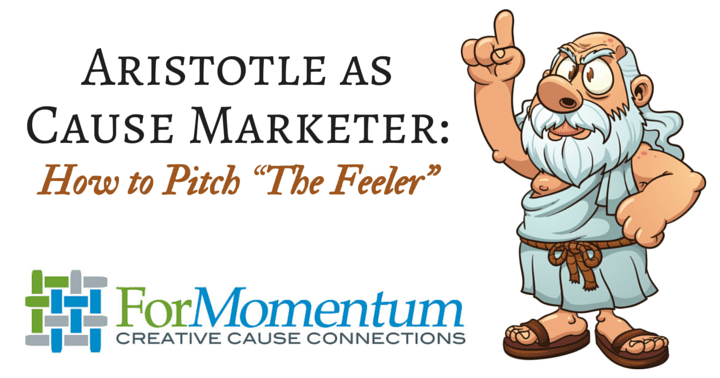
By Joe Waters, Guest Contributor, Selfish Giving
Two things I enjoy about contributing a monthly post to For Momentum’s Cause Marketing Focus blog are: (1) writing about the things I read and (2) reading about the things I write.
For example, in May, I read this fascinating article about how the much-feared T-Rex began as a much smaller dinosaur. As its brain power grew, so did its brawn. I applied this to cause marketers and wrote “Brains Before Brawn: The T-Rex’s Guide to Growing Your Cause Marketing.”
Writing about the T-Rex piqued my curiosity about prehistoric life and led me to a great book on why humans survived and thrived. One reason we succeeded, when other species like Neanderthals failed, was our brain power and our ability to communicate complex ideas through symbols, and eventually speech.
This got me thinking about the art of persuasion—not a huge leap for me as I studied rhetorical criticism in graduate school. And it led me to another book, Words Like Loaded Pistols: Rhetoric From Aristotle to Obama. From this book I decided to write a series of posts on the three types of decision-makers and the persuasive appeals that move them. Hence, my June post: “How to Pitch a Cause Marketing Program to ‘The Thinker’.”
What I learned most from my May and June posts is that while we like to think of ourselves as very modern and advanced, biologically and developmentally, we’re just babies in the history of the world. Whether we are talking about our brain development or persuasive speech, things haven’t changed that much. This is especially true of the art of rhetoric (aka persuasion) that began just a millisecond ago—relatively speaking—in Ancient Greece.
This is a roundabout way of introducing my second post in the series on how to pitch a cause marketing program to “The Feeler.” While my first post drew from the latest research on what works with thinkers, this post draws its insights from the ancient past. The larger lesson is that the adage is true: the more things change, the more they stay the same.
Aristotle: The Man with the Plan in the Ancient World
A lot of people talked about persuasion in the ancient world, but Aristotle (384 – 322 B.C.) wrote the first real book to explain how it worked. Truthfully, Rhetoric can’t be even be called a book. He didn’t write it, nor did someone else write it for him. After his death, Aristotle’s students collected and printed his (or their—historians aren’t sure which) lecture notes. This may explain why parts of Rhetoric are nearly unreadable. It’s hard for me to be too critical as I remember only too well how bad my note-taking was back in school. All in all, his students served their teacher well.
One thing Aristotle is clear on in Rhetoric is the power of pathos (aka emotion, feelings) as a persuasive tool. It’s one of his big three; the other two are logical appeals (logos) and appeals to credibility (ethos). I wrote about logos in June. I’ll write about ethos next month. Onward to pathos!
 How to Pitch a Cause Marketing Program to “The Feeler”
How to Pitch a Cause Marketing Program to “The Feeler”
Feelers are driven by their emotions. Unlike thinkers, feelers don’t fixate on graphs, charts and numbers. They look at the pictures you share with them and listen to the stories you tell them. It’s not about the program making sense. It needs to feel right to them.
Aristotle as cause marketer might offer these insights on how to engage “The Feeler”:
Know Your Key Emotion
It’s important to know what the key emotion is. If you work for a children’s cancer hospital, your key emotion may be sympathy. Truly, who doesn’t feel bad for children with cancer?
On the other hand, if you work for an animal rights organization, indignation or outrage may be your key emotion. I supported PETA earlier this year because of a video on Facebook of dogs being slaughtered in a meat factory in China. “No way!” I railed. “People can’t treat man’s best friend this way!”
Knowing your organization’s key emotion helps you develop appeals that resonate with others. It’s a good place to start!
 Know the Key Emotion of Your Decision-Maker
Know the Key Emotion of Your Decision-Maker
There is one thing better than knowing your key emotion: knowing the key emotion of your decision-maker. This requires a little research, but you can find it.
What other organizations do they support? For example, do they support other children’s causes like yours? What have they said about why they support these organizations? Do a Google search on them. Have they talked about why they support these organizations? What motivates them?
Here’s how this information could be useful. Say that you represent a children’s cancer hospital, but your feeler decision-maker has supported causes that fight social injustice. While you may be tempted to lead with your sympathy appeal, you may be more successful leading with your work with low-income families, regardless of their ability to pay.
Remember, persuasion occurs through identification. The closer you can link your emotional appeals with your decision-maker’s key emotion the more convincing you’ll be.
Know How to Balance Emotion with Other Appeals
Because causes are no strangers to emotional appeals, dealing with feelers is easy and natural for most nonprofits. However, take care to avoid these hazards:
- Don’t overdo it. Even with feelers, an overly emotional pitch can be a big turn-off. Emotions are like explosives. A little bit of dynamite can pack a lot of punch. Think twice about how much you use.
- Target the head and the heart. You can balance the two by using facts and figures to appeal to the prospect’s logical side. Then use stories to build an emotional connection.
- Stay positive. Research on fear appeals shows that when they are overused people will shut down and tune you out. Have you ever felt this way when a fundraising appeal overdid fear, anger, guilt, or shame? What’s more effective is to focus on hope, joy, love, respect, and other positive emotions.
People want to feel good about supporting a cause. Don’t deprive them of that, or they may deprive you of their support.

[…] three types of decision-makers I’ve discussed in this series (Thinkers in part one and Feelers in part two), Deferrers fascinate me the most because they are full of faith in the wisdom of […]